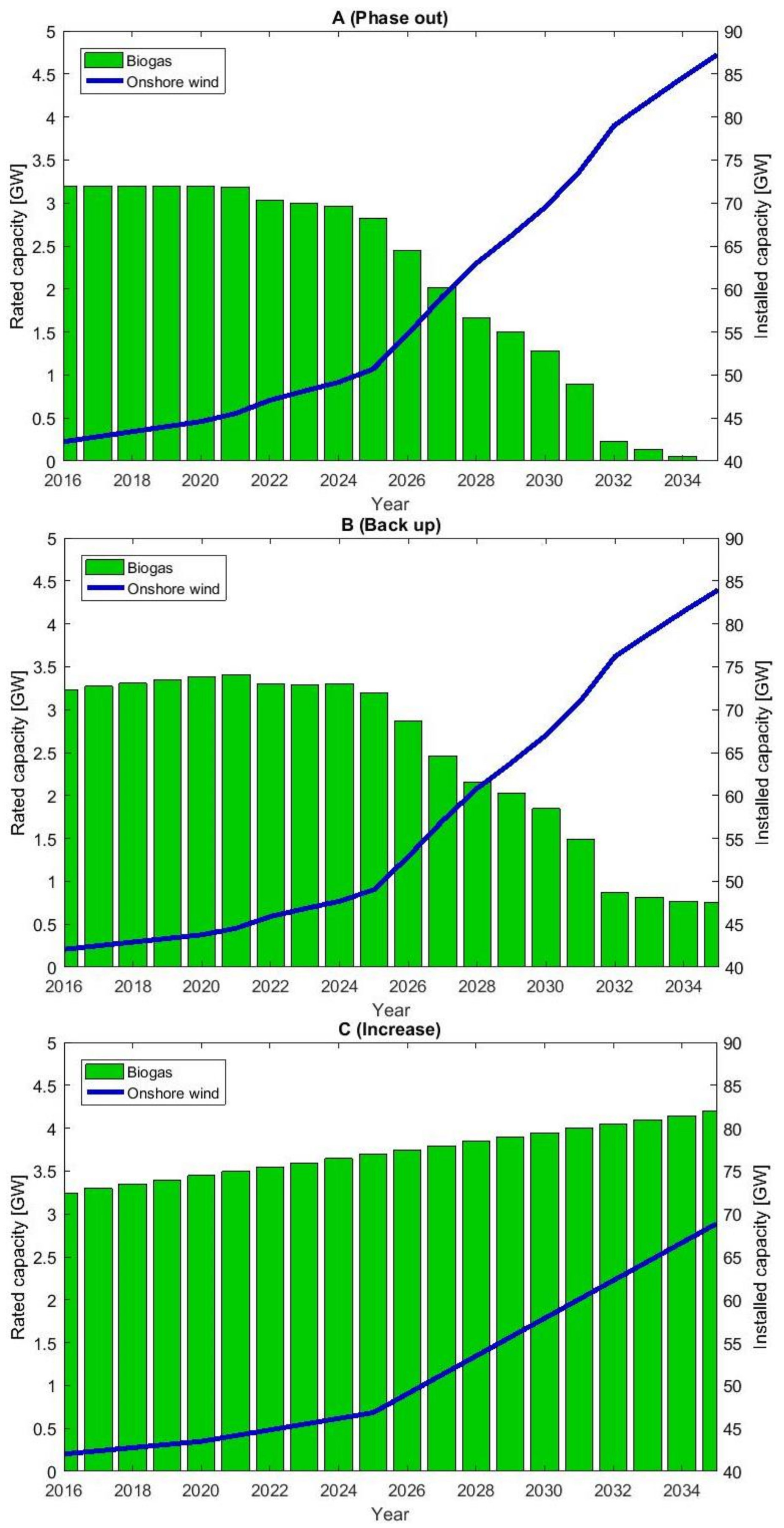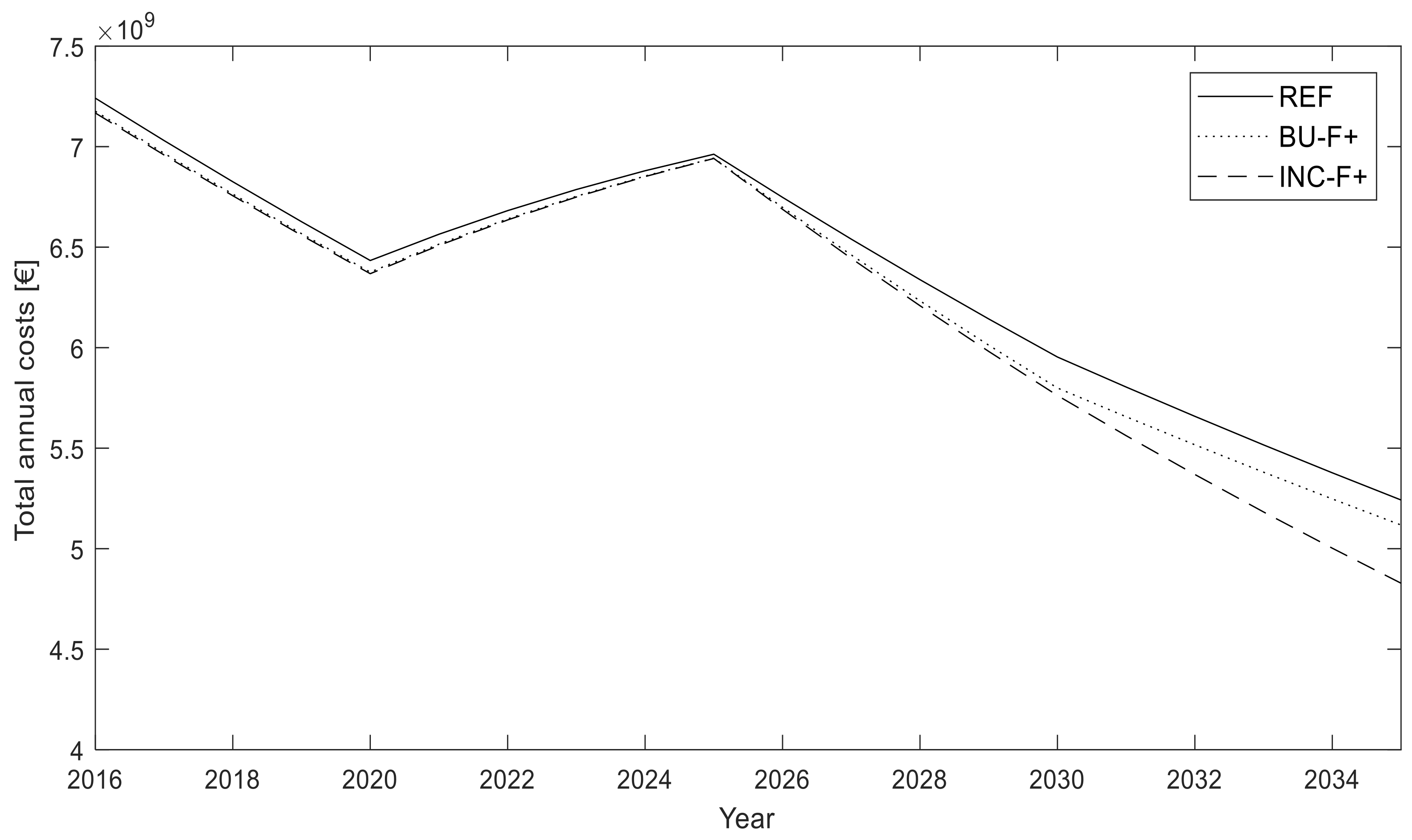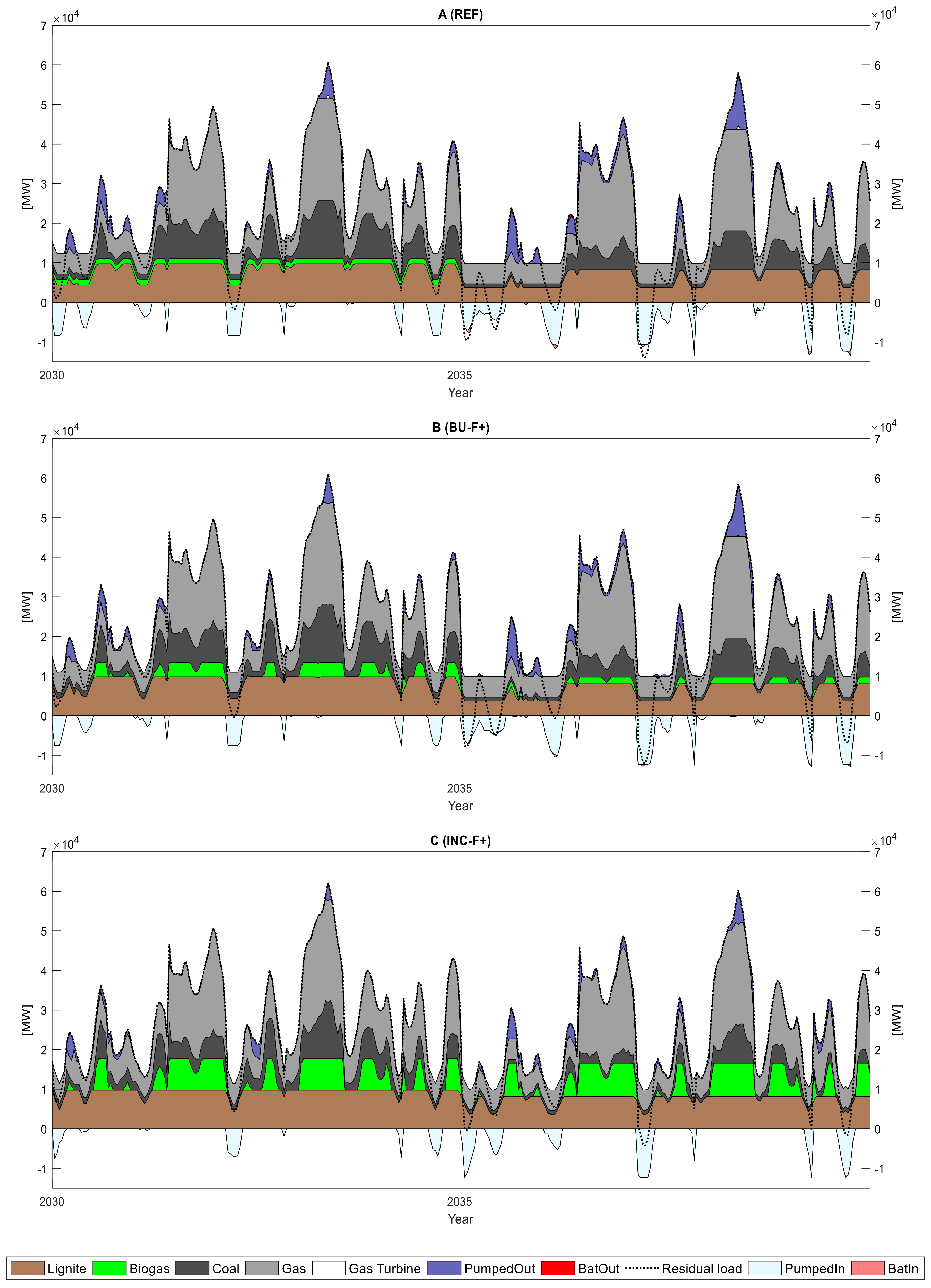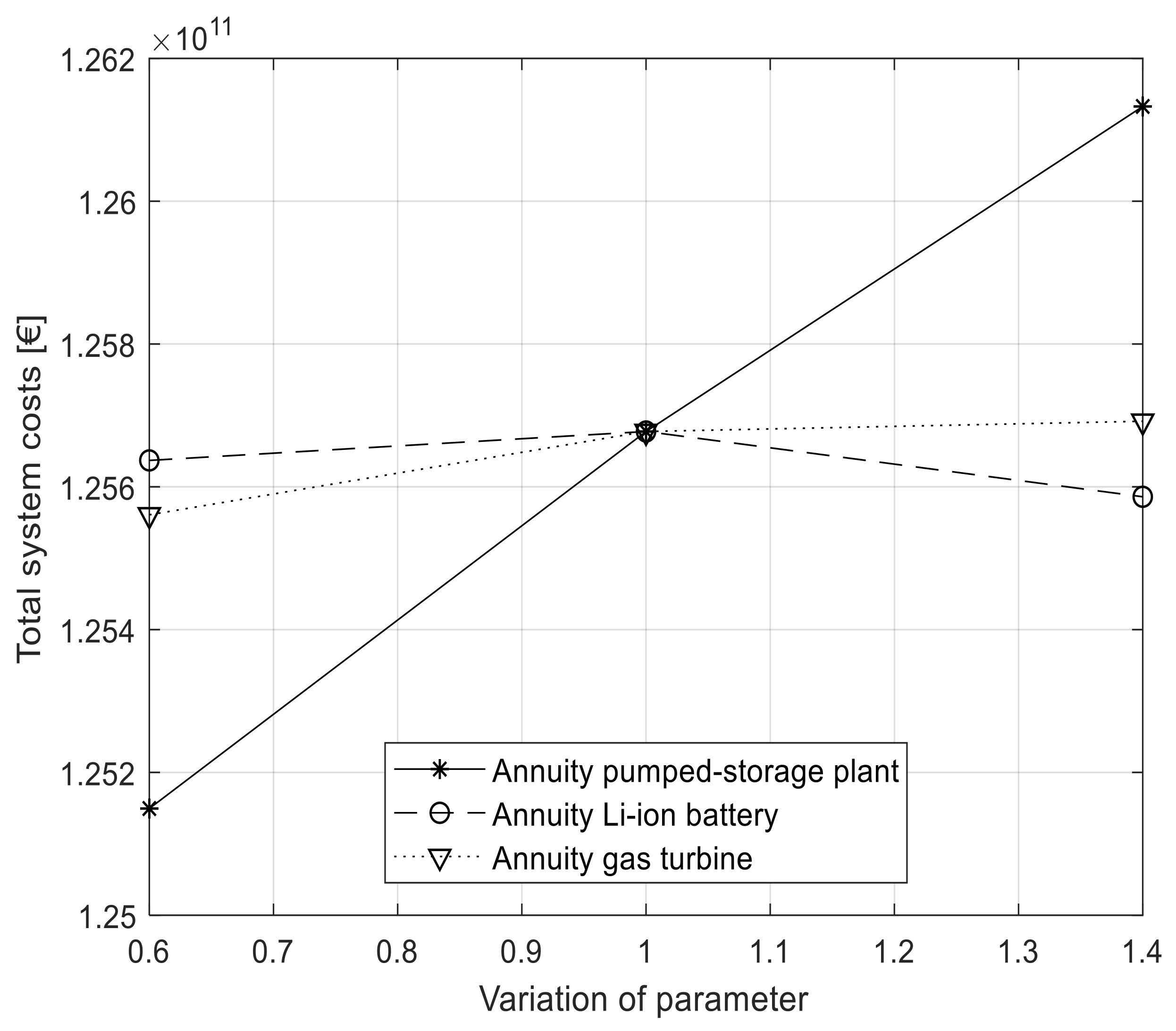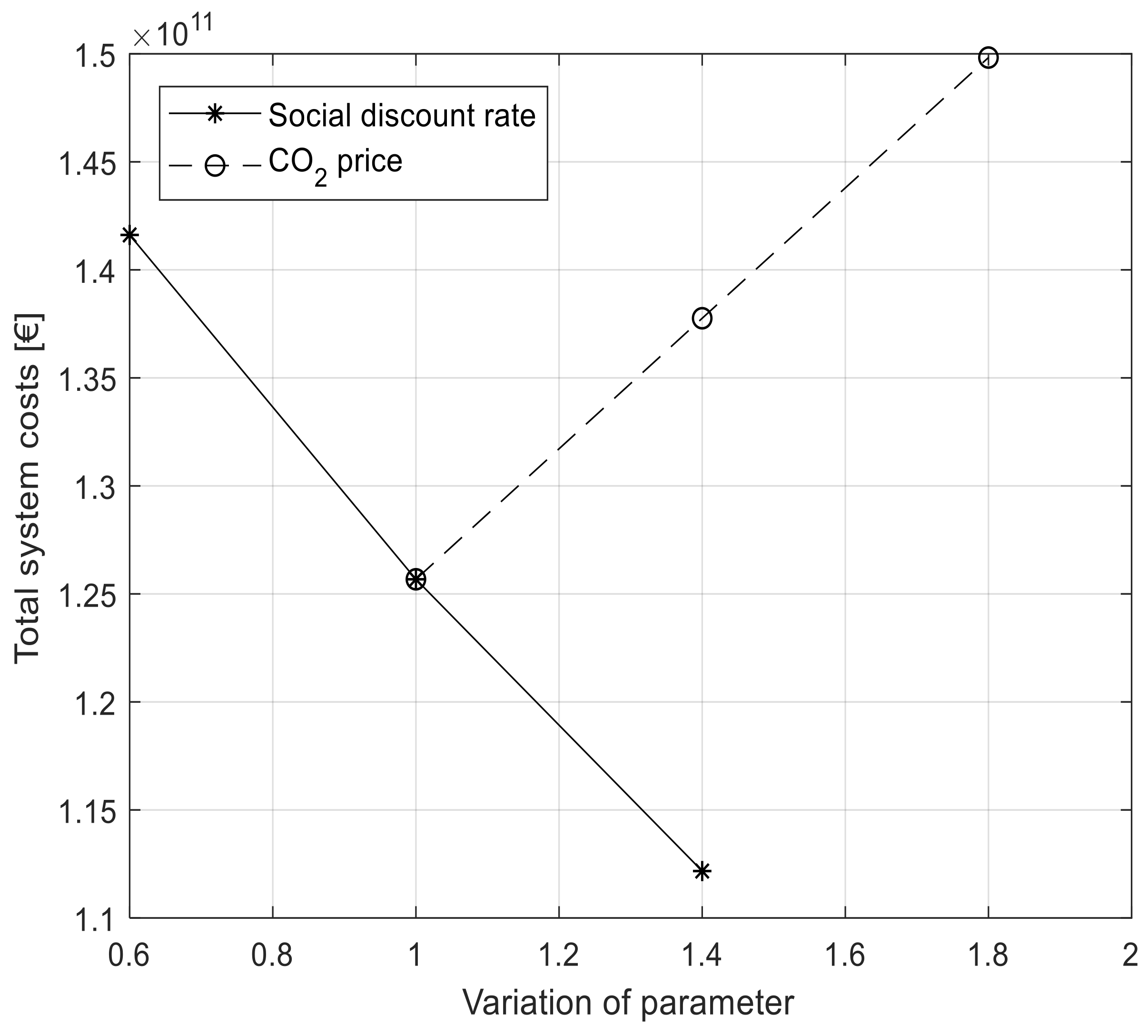1. Introduction
The increasing greenhouse gas (GHG) emissions and the resulting negative impacts of climate change compel the international community to act. In December 2015, the Paris Agreement was signed to limit global warming to one and a half degree Celsius compared with preindustrial levels [
1]. Worldwide, net zero carbon emissions has to be achieved by the middle of the 21st century [
2]. By 2050, in order for Germany to reduce GHG emissions by at least 80% compared to 1990, the German government’s Energy Action Plan 2050, signed in 2016, aims to decrease total GHG emissions by 55–56% and the energy sector’s GHG emissions by 61–62% by 2030 [
3]. The proportion of renewable energies in the electricity system is specified by the Renewable Energy Sources Act (EEG), by 2025 the proportion should make up 40–45% of gross electricity consumption and by 2035 55–60% [
4]. According to the EEG, the future German electricity generation will be based on intermittent renewable energies, namely wind and photovoltaic plants [
4]. Due to their intermittency of power generation, further technologies balance the demand and supply, such as demand-side management (DSM), grid extension, storage technologies, and supply-side flexibility, which can be used to integrate them into the energy system [
5,
6]. In contrast to other countries in Europe, in 2016 17.2% of Germany’s renewable electricity generation was generated by biogas plants [
7], whereby these are the most important dispatchable renewable energy. As a consequence, flexible power generation from biogas plants can be one technical solution of low GHG emissions to integrate intermittent renewable energies into the electricity system [
8,
9,
10]. Furthermore, compared to the use of biogas and biomethane (a natural gas substitute) for direct heating or transport in Germany, the highest GHG emission savings can be achieved by the generation of heat and electricity in combined heat and power units (CHPU) [
11].
Nevertheless, in 2016, the German Government has decided to decrease the installed capacity and the electricity generated by biomass (and biogas) plants within the next decades. The EEG reform limits the annual expansion to a maximum of 150 MW (2017–2019) and 200 MW (2020–2022) [
4]. Due to the average biogas plants installation of 350 MW per year in the period of 2004–2014 [
12], fewer biogas plants will be built and those remaining will begin to close down after their 20 year periods of remuneration in the 2020s. As a result, the installed capacity of biomass, and especially biogas plants, will be reduced and other flexibility options will become more important to ensure there is a sufficient power supply based on intermittent renewable energies in the future German electricity system. If flexible power generation from biogas plants decreases, additional capacities of storage technologies and dispatchable (conventional) power plants might be needed that accompany enhancing investments. In this study, we calculate the total system costs in the future German electricity system depending on varying biogas extension paths.
The cost-effective transformation of the energy system towards decarbonization and an increasing proportion of renewable energies in the electricity, as well as in the heating and mobility sector, is a topic of a high number of publications in recent years. Urzúa et al. [
13] showed the impact of an increasing proportion of intermittent renewable energies on the total system costs in Chile. Due to additional costs for transmission and renewable energy capacities, the total costs increase with further wind and solar plants. Due to this, the investments in coal-fired power plants and their base-load operation are cheaper than the combination of (intermittent) renewable energies and transmission grids. Therefore, they argue that dispatchable renewable energies, such as base-load generated hydropower or biomass, can be better integrated in the existing energy system of Chile. Jacobson et al. [
14] analyzed the social cost of a 100% renewable US energy system by 2050–2055, including all sectors. Compared to a fossil system, they calculated that the power generation by wind, water, and solar is more economically feasible when the cost of health and climate are integrated. The cost of the electric system in a renewable energy system is about 11.37 ct∙kWh
−1, while, including the externality of conventional power generation, the cost of the electric system is given of 27.6 ct∙kWh
−1 in a non-renewable energy system. Budischak et al. [
15] optimized the least-cost combinations of intermittent renewable energies and storage technologies in a large regional grid in the Eastern USA. The aim is to supply the demand in this area. They found that when 290% of the demand is generated by the optimal combination of renewable energies and storage technologies, 99.9% of the hourly demand over four years can be covered. Depending on the chosen storage technology only 9–72 full load hours of storage technologies are required to fulfill the target value. Furthermore, regarding the technology costs by 2030, the renewable energy electricity system will be more cost-effective than the conventional one today.
In Europe, similar studies regarding the transformation process of the energy system were also carried out. Heide et al. [
16] calculated the optimal mix of photovoltaics (PV) and wind power plants in a fully-renewable European power system to minimize three different objectives: storage capacities, balancing energy, and balancing power. According to their results, depending on the objectives, three different optimal solutions were found. To minimize the storage requirements, the mix of 60% wind and 40% PV has to be chosen when ideal roundtrip storage is used. Nevertheless, they do not take economic analysis into account. Pfenninger and Keirstead [
17] combined three technologies, namely renewables, nuclear, and fossil fuels used in Great Britain’s power system to reach different targets of CO
2 emissions reduction, energy security and system-wide levelized cost of electricity (LCOE). Their analysis showed that different combinations of the chosen technologies lead to similar results. From the perspective of renewables, a proportion of up to 80% relates to a significant increase of cost. However, a proportion above 80% asks for high investments in large-scale storage, imports of (renewable) power, or additional dispatchable renewables. Brouwer et al. [
18] analyzed which flexibility options in the Western Europe power system should be used to minimize the total system costs 2050. These included demand response, natural gas-fired generators, interconnection capacity, curtailment of intermittent renewables, and electricity storage. With the exception of storage technologies, all flexibility options may reduce total system costs within varying proportions of renewable energies. Zakeri et al. [
19] examined the technical and economic feasibility of flexibility options to integrate intermittent renewable energies in energy systems with a high proportion of non-flexible nuclear power generation. However, the role of biomass as a flexibility option and its impact on total system costs is not shown in detail, although, these plants are assumed as flexible as coal-fired power plants with carbon capture storage.
In Germany, based on a high proportion of biomass plants, several studies analyze their current and future role in the electricity system. Holzhammer [
20] calculated that flexible power generation from biogas plants and biomethane CHPU might reduce total system costs in 2030. One reason is that it saved fuels and the lower numbers of start-stop operations, inter alia, by conventional power plants overcompensate additional costs for flexible power generation from biogas plants with a number of 4000 full load hours per year. In a previous study [
21] we assessed the flexible biogas power generation using the average integration costs of surplus generation (AICSG) for the period of 2016–2035, which is defined as a quotient of remuneration and surplus generation. We find that biogas plants have to be as flexible as possible to smooth the future residual load curve and to reduce the further demand for flexibility options in Germany. Furthermore, the increasing extension of biogas plants may be more cost-effective for the system integration of intermittent renewable energies than their reduction or phase out. In another study for Germany, Eltrop et al. [
22] calculated, endogenously, the installed capacities of lignite-, coal-, gas-fired power plants, biomass plants, and storage technologies using the European Electricity Market Model E2M2s. It is shown that varying the proportion of renewable energies (40%, 60%, and 80%) an endogenous extension of the installed capacity of flexible biomass plants can reduce the total electricity system costs. The annual amount of electricity generated by biomass plants is set to be constant. Due to saved investments in storage technologies and conventional power plants, regarding a proportion of 80% of renewable energies, flexible biomass plants reduce the total electricity system costs by 419 million € (compared to baseload generation).
To summarize, the above-mentioned studies show the impact of renewable energies on total system costs or the demand for further technologies to balance demand and supply, which become more important during the energy transformation process. The future role of flexible power generation from biomass plants is especially analyzed in German publications. Nevertheless, the impact of varying biogas extension paths exogenously by policy makers on the composition of flexibility options and the total costs in the future German electricity system is not taken into account in previous publications. In contrast to the endogenous optimization of flexibility options, e.g., in [
18], the installed capacity of Germany’s biogas plants is set by the EEG based on the decision of the German Government. Furthermore, according to the EEG revised in 2016 [
4], details of the flexible biogas power generation are given by policy makers. For example, the power quotient PQ [
9] which is defined as the quotient of installed and rated capacity—the annual average of electricity generation—of biogas plants has to be 2 or higher (EEG 2017, § 44b). With regard to the transformation process of the energy system towards renewable energies, the future role of flexible power generation from biogas plants determined exogenously by policy makers has to be assessed. In addition to other flexibility options, biogas plants might be one cost-effective option to integrate intermittent renewable energies into Germany’s energy system.
In this paper, we assess the composition of flexibility options and the total costs in the German electricity system for the period of 2016–2035 by using a non-linear optimization model varying the extension path and mode of operation of biogas plants.
The objectives can be defined as follows:
To analyze the impact of varying proportions of biogas plants on the required power generation from conventional power plants;
To minimize the residual load demand by the optimization of flexible power generation from biogas plants; and
To examine the effect of flexible power generation from biogas plants on the total costs of the electricity system.
5. Conclusions and Policy Implications
In this study, we analyzed the impacts of varying biogas plants extension paths, including Germany’s existing biogas plants, and modes of operation on the total system costs in the period of 2016–2035 by using a non-linear optimization model. We found that an increasing proportion of (flexible) biogas plants in the future German electricity system reduces the demand of storage technologies and flexible conventional power plants to supply the demand. Without taking into account the capital and marginal costs of biogas plants, they can be a cost-effective flexibility option (compared to other technologies).
Firstly, the replacement of intermittent onshore wind capacities by dispatchable biogas plants smooths the residual load curve and reduces the demand for further flexibility options. Secondly, the operation of biogas plants should be as flexible as possible to increase the effect on the future residual load curve and the reduction of the total system costs. However, the findings underline that the biogas extension path
back up may be a more economically feasible way to integrate intermittent renewable energies into the electricity system than the continuous increase in the extension path
increase. Regarding the total costs, the marginal utility in the extension path
increase was lower than in the extension path
back up and emphasizes, under the assumptions considered, a constant increase of biogas plants may lead to additional system costs. Our model results specify that Germany’s electricity system is characterized by sufficient capacities of flexibility and additional flexibility options are needed from about the year 2030 onwards. Thus, in the short-term, there is no need to implement further flexibility options when the extension paths of renewable energies and the decrease of the installed capacity of conventional power plants remain unchanged. However, due to Germany’s ambitious GHG reduction target values and the goals of the Paris Agreement, the utilization and the installed capacity of lignite-fired, as well as coal-fired power plants have to be reduced more rapidly [
62]. Furthermore, the decarbonization of the energy systems also requires the use of renewable electricity in the heating and mobility sectors [
63], whereby extension of intermittent renewable energies should be further enhanced, compared to the defined annual increase of renewable energies in the EEG (EEG 2017, § 4). Depending on the capacities of conventional and renewable capacities, additional flexibility options may be needed before 2030. To summarize, based on the future extension paths of renewable energies and the installed capacity of conventional power plants, (flexible) biogas plants can be a cost-effective subset of future flexibility options to integrate intermittent renewable energies into the electricity system.
From the broader perspective of policymakers, we recommend the following strategies:
The economic assessment of flexibility options in the electricity system has to include the interactions between these options and all conventional, as well as renewable energy provision technologies, within Germany’s electricity system. From the year 2030 onwards, flexible power generation from biogas plants can be an option to decrease the total system costs in Germany’s electricity system.
The optimal installed capacity and mode of operation of biogas plants depends on the development of conventional and (intermittent) renewable energies in the future electricity system.
To increase the market penetration of flexible power generation from biogas plants, additional market revenues are needed. This can be achieved by the reduction of conventional power plants in baseload operation.
Due to the limited potential of biomass, the economic assessment of biomass use in the energy system should also be taken into account in different areas of application: e.g., the production of basic chemicals based on biomass might be necessary if GHG emissions are reduced up to 95% by 2050.
For further research, we suggest a cost-benefit analysis to finally assess the most cost-effective extension path and mode of generation of biogas plants in the future German electricity system. Therefore, the varying costs of the intermittent renewable energies and of biogas plants, respectively, in all scenarios have to be taken into account. A cost-benefit analysis would enable a comprehensive economic assessment that considers the discounted costs and benefits over the period considered.
